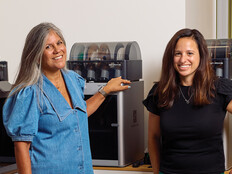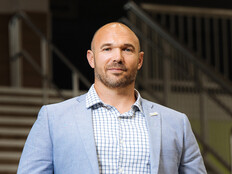Classrooms for the Future
A little money to spend on technology is nice, but Pennsylvania’s education department has a bigger goal in mind for its $20 million largess.
When news of Pennsylvania Gov. Ed Rendell’s Classrooms for the Future program crossed Jane Hershberger’s radar screen, her excitement level rose rapidly.
“I thought, ‘This is awesome,’ ” recalls the assistant principal at Avon Grove High School in West Grove, Pa. “That money would really help us move our kids forward.”
Administrators at the 1,200-student school already had begun to implement interactive technology in its classrooms, but each department had, at most, two interactive whiteboards and a cart of notebooks to wheel from room to room. The $158,473 grant Hershberger received from the state program bought 24 notebook computers, 24 interactive whiteboards — one for each English and math teacher in the building — and three mobile carts of 30 notebooks each for student use.
Franklin Regional School District, 20 miles east of Pittsburgh, considers itself a digital school district — one of the first six schools the state identified as such in 2000. So Frank Muto, the district’s supervisor of technology, had deployed wireless capabilities at the high school and amassed 13 mobile labs for those students. His $123,141 grant means he can equip 22 classrooms with interactive whiteboards and give 22 teachers the notebooks to run them.
“Right now they’re using a desktop to try to connect to everything or borrowing one of the student’s, which means the classroom is short,” says Tina Burns, principal at Franklin Regional High School.
Hey, Coach!
Educators across the state recount similar stories. The program’s goal is to put a notebook computer on each desk and electronic whiteboards, cameras and scanners at teachers’ disposal in every high school English, math, science and social studies classroom in Pennsylvania by 2009. In the first year, the grant helped equip 1,200 classrooms in 103 schools with 16,000 notebooks. There are grander plans for 2007–2008. All told, it’s a $200 million investment for the next three years.
But while press releases highlight the money, “the idea is to accelerate student learning,” says Gerald Zahorchak, the state’s secretary of education. “It’s a way to bring 21st-century technology into our high schools, but the heart of the program is about teacher development, putting a lot of emphasis on how to prepare teachers to introduce best teaching practices.”
That’s why each grant award includes a technology coach, fresh from absorbing the Annenberg Foundation’s coaching model and armed with standard outcomes to achieve. Putting a coach in each high school means the professional development is personal and relevant to each instructor’s content area, Zahorchak points out. “It’s not just spray-and-pray or a ‘what was that about?’ drive-by. We want to know that the teacher understands the data, understands best practices and knows how to differentiate instruction for a particular student by name.”
Joe Baker, Franklin Regional’s technology coach, agrees. “If you just purchase a large amount of equipment and place it in a classroom with no professional development, it collects dust,” he says. As a former classroom teacher, he regularly used most of the equipment but has discovered that many of the teachers under his wing don’t have much notebook experience.
“As educators we make a lot of assumptions,” Burns says. “In business, you buy a new copier and think all the employees know how to use it because they could operate the last one. But it may have some additional functions that could make work and productivity better. The same applies to education.”
New Markers
Pennsylvania’s program timing is impeccable; an industry trade publication gave the state a “C” in its spring 2006 technology report.
“Our high schools are just not where we are happy as a nation,” Zahorchak admits. Count on his department to keep an eye on standardized test scores in the next three years and to track the number of students who take and pass Advanced Placement courses. He’s also watching SAT scores, attendance and graduation rates for an ongoing assessment rather than relying on a time-frozen snapshot.
Burns plans to start her internal assessment by surveying students in technology classrooms. “In terms of measurements, we’ve done surveys in the past for both staff and students, so we have qualitative information,” says Muto. “When you talk about quantitative information, that’s about longitudinal types of studies and much longer periods. Right now not many districts other than the big ones in Texas have done that.”
Hershberger’s own measurement standards are more precise. Avon Grove High School is shooting for 100 percent state standardized test scores in reading, math and writing by 2014, with percentage increases along the way. With math scores currently at 69 percent proficient and reading scores at 77, “We have some work to do,” she says. “We are hoping that the teachers’ effective use of instructional technology will get us there.
“I really think this technology will allow us to teach kids the way they want to learn,” she adds.
The Goods
Here’s a list of items Pennsylvania schools can buy with the state grant:
- Lenovo ThinkPad notebooks
- Microsoft Office 2007
- Inspiration Software
- Adobe Creative Suite
- Promethean interactive whiteboards
- PolyVision interactive whiteboards
- D-Link access points
- HP multimedia printers and digital cameras
- Canon video cameras
- Bretford mobile notebook carts
- Epson projectors
- Logitech Webcams and speakers
More Than Test Scores
Test scores aren’t the only boon Jane Hershberger, assistant principal at Avon Grove High School in Pennsylvania, hopes to gain from her state’s technology grants. Sure, higher test scores are the goal, but along the way she’d also like to see the following:
- Rising attendance figures. The high school enjoys a 96 percent attendance record on any given day, but she anticipates “using that cool technology in English and math will make students think, ‘Wow, school is pretty cool.’ Not that they would articulate that.”
- Fewer discipline referrals. “When kids are engaged, they don’t act out,” Hershberger says.
- Better ESL scores. Learners of English who may not understand every word spoken in the classroom should grasp concepts easier when they’re also presented visually.
- A perfect graduation rate. Avon Grove graduates roughly 95 percent of its students every spring. “That’s not good enough.”







